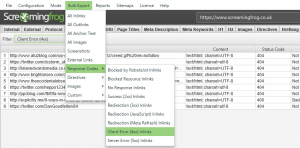— November 2, 2017

Couleur / Pixabay
Fall is here, and you know what that means: Pumpkin spice flavors in everything, football on every television, and flannel on every clothing store mannequin. These fall flavors tend to dominate the season, but once that’s over, businesses are usually left holding the bag in the form of excess inventory.
To be fair, that’s true of almost all seasonal trends. People can’t get enough of a certain item for a month or two, and then demand plummets. Have you ever seen someone drink a pumpkin spice latte in May?
Some businesses are built around this ebb and flow. Retailers know all too well the surges in demand that holidays bring, followed by lulls; landscaping companies know that business will dry up after the leaves fall; and so on.
Other companies treat trends like waves they need to ride for all they’re worth. That’s how you end up walking into a store to find deeply discounted fidget spinners in a box near the door.
Considering the financial implications of season fluctuations, it’s surprising that more small businesses haven’t switched to an automated inventory management system to help them manage their supply more efficiently. According to the Wasp Barcode State of Small Business Report, 43 percent of small businesses don’t track their inventory or use a manual process to do so.
Expect that number to continue falling—as it has slowly over the years—as businesses recognize the value in automated inventory tracking. Here are the benefits that a system like that can bring you, especially when dealing with fall flavor trends that you’ll want to take advantage of, without overextending yourself.
1) Don’t Drown in Excess Inventory
If you’re in a business that can capitalize on a fall trend, you may be tempted to load up on that product, buying materials in bulk to get a better deal. But what happens if demand doesn’t end up meeting your supply?
When that happens, businesses often suffer from the “carrying costs of inventory.” These costs are typical, and they include money spent on warehouse storage space, insurance, and investments in the conditions that will keep your inventory in peak condition. But when you have excess inventory, these costs add up, and can eat into your profit. Discounting that inventory may get it off your shelves, but will negate any money you saved by buying in bulk.
It’s believed that companies can boost their profitability by as much as 50 percent through careful inventory management. Best practices involve “pulling” inventory, rather than pushing it, and using historical trends and current sales to determine when to place re-orders, rather than (educated) guesswork.
2) On the Other Hand, Have Enough On Hand To Meet Surges In Demand
You don’t want to suffer the opposite problem either: Being so afraid of excess inventory—maybe you were burned in the past?—that you under-order and end up sold out when demand is peaking.
There is a ripple effect when your business doesn’t have enough inventory to meet demand. Not only do you lose sales, but you can lose customers altogether—why would they return to a site or business that doesn’t have what they need?—and gain a poor reputation.
And if you try to make up for not having the inventory on-hand by placing rush orders, you spend more money just to complete a simple request. An analysis from the University of Rhode Island says that “cost increases due to insufficient inventory, low-quality product and the like lead to customers not returning.” The best way to avoid these costs is to have an optimized supply chain, which typically features automated systems.
3) Don’t Lose Inventory To Theft, Loss, Or Other Issues
As a business owner, you might want to believe that every order you put in for inventory will arrive perfectly intact. You probably (or at least, you should) trust your suppliers and your employees to make this happen.
But things happen. Items fall and break. They get mishandled and lost in transit. And sometimes people steal them.
A National Retail Federation/University of Florida survey found that “inventory shrink” cost retailers $ 48.9 billion last year. Employee theft was the second-biggest contributor after shoplifting, according to the survey.
But when your business and supply chain use barcode labels and scanners to keep track of inventory, there’s greater accountability for everyone involved. When each product has a corresponding barcode and place in the system, it’s easier to track where it might have gone missing along the supply chain. That keeps people honest and makes it easier to identify those who might be inclined to be less-than-honest.
4) Save Time and Energy
Using a pen and paper, or worse, mental math, to keep track of inventory may have been the standard for decades, but we know too much about inefficient these manual methods are to continue using them.
When you need to keep track of hundreds, thousands, or even hundreds of thousands of products, you need the help of automated systems. Relying on humans means almost guaranteeing errors will creep into your inventory records, which will create issues (either triggering re-orders when none are needed, or vice versa). Spreadsheets have remarkably high error rates—it’s believed that over 90 percent of spreadsheets contain errors—and even worse, people tend to greatly underestimate their own capacity for error. Take that questionable overconfidence out of the equation entirely with automated software.
Beyond avoiding stocking errors, letting humans utilize barcode scanners and the like will save them valuable time and energy, and allow you to assign your employees to work that isn’t as menial and tiresome.
Other Best Practices For Dealing With Seasonal Trends
If you’re looking for additional tips for dealing with the uptick in demand during certain seasons (and resulting lulls in the proceeding seasons), consider these techniques:
- Budget based on the slower months: Don’t get too far ahead of yourself and start making big payments just because business is in full swing for a few months.
- Overestimate your costs: Your monthly costs last year won’t necessarily predict your monthly costs this year, so add a little extra to make sure you can cover the unexpected.
- Negotiate with your vendors: If you have a good relationship with your vendors, you can negotiate with them to adjust your payment terms during those months when money is tight.
- Pause your subscription services: If you have subscriptions to marketing or SAAS products, consider putting them on hold until you really need them again.
- Explore financing options: A small loan from any number of online or traditional lenders may be what you need to weather a lull, or take advantage of a spike.
Fall is a fantastic time of year for taking walks, exploring foliage, buying trendy clothes, and huddling in front of the TV on Saturday and Sunday afternoons. They can also be a boon time for your business if you plan things out the right way. And in this day and age, no business plan is complete without an investment in automated inventory management. If you’re not on board already, look into your options before you’re left behind.
Business & Finance Articles on Business 2 Community
(36)







